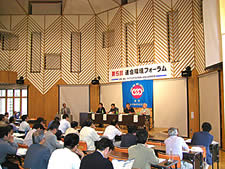Fifth RENGO Environmental Forum Held
(30 May 2003)
 |
| Photo: “From Pollution to Environmental Issues” was the theme of the debates. (22nd, Minamata) |
RENGO Kumamoto President Kawase stood for a speech and said “corporate ethics, the workers working there, and the very philosophy of trade unions are in question.” He called on participants at this forum to learn from Minamata disease and to work for environmental problems in every workplace and at each locality. At the forum, Ashikita Town Mayor Takesaki offered a speech, messages were delivered on behalf of Kumamoto Prefectural Governor Shiotani and Minamata-city Mayor Eguchi, and there was various discussion of expectations for RENGO Eco Life 21.
Kumamoto Gakuen University Department of Social Welfare Professor Harada gave the keynote lecture, titled ‘What We Can Learn from Minamata Disease: Social Responsibility and the Role of Trade Unions.‘ In his lecture, Professor Harada stated “if the influence of environmental pollution is imposed on anyone, it is the socially vulnerable such as unborn children, infants, seniors, and those who live in harmony with nature.”
He touched on the topic of Minamata victims who are forced to live with severe discrimination saying, “Pollution problems generate discrimination. Around 1960, (Minamata disease was only discovered in 1956) even the trade unions were not on our side.” Continuing, Dr. Harada pointed out “wasn’t it the duty of labor unions to stand up for the weak? I think their real role lies here.“ He emphasized that “to live as a worker is to really be alive.” He spoke of the necessity of working on environmental problems, making equal footing for patients, specialists, workers in the workplace and administrations and barrier-free concepts.
After RENGO-prepared environmental measures were proposed, a panel discussion was held. Minamata Disease Museum Minamata Disease Oral History Society President Hamamoto, former Shin-Nippon Chisso Hiryo Labor Union Chair Yamashita, and former Minamata-city Mayor Yoshii each talked about how to share the lessons learned from Minamata disease. Each stated “putting these lessons to good use means to act. We should start working on whatever is close at hand. Are the lessons we have learned from the disease being put to sufficiently effective use with regards to information disclosure and/or risk management now? Have citizens acted ethically and morally? We need to dig down and take a hard look at ourselves.” Furthermore, Ministry of Environment Global Environment Division Global Warming Policy Bureau Director Shimizu queried, “isn’t it possible to act together with people who are actively taking part in administration, labor unions, patients organizations and localities without barriers? We hope to promote an environmental administration that creates something new where everyone is on equal footing.“
Finally, RENGO Assistant General Secretary Murakami stated that “neither Minamata Disease nor environment pollution have been terminated. We should always remember this and pay attention to various matters while continuing to think about how we can forestall new pollution in the future.” He also called on attendees to fortify RENGO Eco Life 21 activities and said, “we hope to create a new movement that will be recognized in the workplaces. The most important thing is to act.“ He appealed to the audience by saying, “I want all of you to begin working on activities for environmental problems today,” and after so saying, closed the forum.